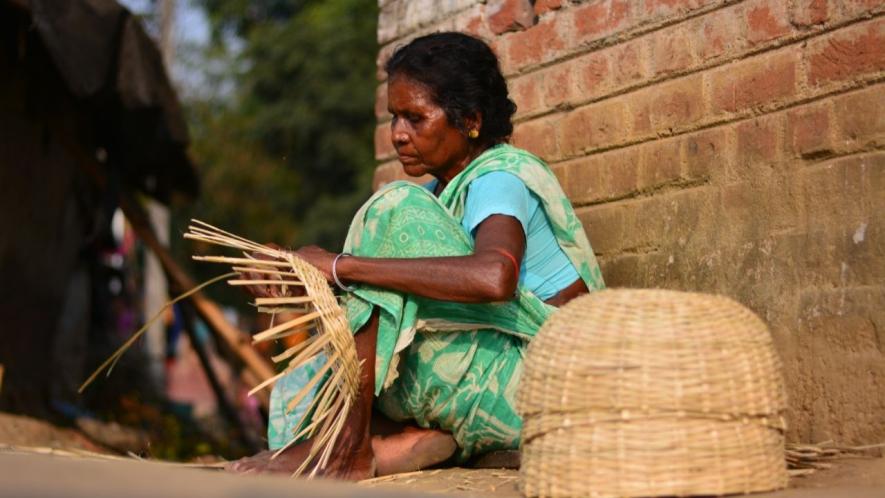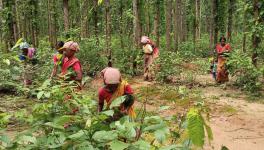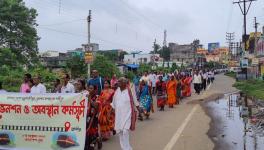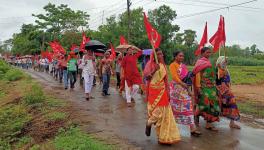Gramin Banks Have Abandoned the Poor in Jangal Mahal

Ranu Bauri an old-age woman from Bhutsahar village under Bankura 2 Block is making bamboo baskets with a loan from Microfinance Company. Gramin bank reluctant to give loan.
Have Gramin Banks (Regional Rural Banks or RRBs) retained the vision with which they were introduced nearly half a century ago? This question has arisen in people’s minds after observing the activities of rural banks in our country, particularly in remote areas, during the past ten years. RRBs were established through an ordinance promulgated on September 26, 1975, and subsequently formalized through the Regional Rural Banks Act, 1976. Their primary goal was to develop the rural economy by providing financial support for agriculture, empowering farm labourers, small traders, artisans, small entrepreneurs, and promoting other productive activities in rural areas.
However, are the intended beneficiaries truly receiving these opportunities from the rural banks? Have rural banks maintained the trust and reliance of the people? Most people in the Jangalmahal districts of West Bengal say, “No.” They argue that rural banks have completely deviated from their original mission. At one time, these banks were the primary financial lifeline for many. Now, the local economy is dominated by several microfinance companies, and in this unstable situation, the rural banks seem to have turned their backs on the people.

Belmala artisan at Mejia Bankura who got a loan six years ago from Gramin bank.
RRBs’ Historic Role
The role of rural banks in establishing a strong foundation for the rural economy has been significant. During the 1970s, agricultural production across India was at a low, except in Punjab. The Green Revolution, introduced in Punjab, led to a remarkable increase in agricultural output. By the 1970s, Punjab was producing 70% of India’s total food grains, while other states depended on it for their food supply. Due to financial constraints, inadequate irrigation, and other issues, many farmers were unable to cultivate their land. Despite this, a large number of farmers relied on high-interest loans from local moneylenders and struggled to proceed with cultivation due to their inability to repay these loans. Nationalized banks had inadequate plans to support farmers in this regard. This lack of cultivation contributed to a food crisis, with food scarcity becoming a growing concern.
Wheat output declined from 26.4 million tonnes in 1971-72 to 21.8 million tonnes in 1973-74, and rice production also decreased from 42.22 million tonnes in 1970-71 to 39.24 million tonnes by 1972-73. Both rice and wheat production continued to decrease until 1976, leading to widespread food shortages exacerbated by hoarding. West Bengal, a leading state in rice production, was not immune to this crisis, particularly in the Jangalmahal region. Thousands of poor, marginalized, and lower-middle-class people from Bankura, Purulia, Jhargram, and Paschim Medinipur districts were compelled to seek work elsewhere in the state and country. Many lived in dilapidated houses and faced severe hardships, with numerous individuals disappearing in the process.

Ranjit Malla a farmers of Bhadul village of Bankura 2 Block cultivated cabbage with a loan from money lender
In response to the rural economic challenges, the Central Government initiated the establishment of rural banks in the country. On October 2, 1975, five RRBs were inaugurated, including the Gour Gramin Bank of Bengal and the Prathoma Gramin Bank of Uttar Pradesh. The RRB Act of 1976, enacted by the Union Government, led to the creation of 196 RRBs across India, with nine located in West Bengal. The Mallabhum Gramin Bank was established to serve the districts of Jangalmahal, including Bankura, Purulia, and the undivided Medinipur (now PaschimMedinipur, PurboMedinipur, and Jhargram). These rural banks are structured with 50% funding from the Central Government, 35% from sponsored banks, and 15% from the respective State Governments. The framework for these banks remains in place to this day.
“On April 9, 1976, the Mallabhum Gramin Bank was established in the Jangalmahal area of Bengal. After the Left Front came to power in the state in the subsequent years, the financial development of the Jangalmahal region began to improve, thanks to both the state government's initiatives and the Gramin Bank's sensitive approach towards marginalized and poor communities,” said Upen Kishku, a resident of Jangalmahal Raipur and former Minister of the Backward Classes Welfare Department of West Bengal.
Rohini Mahato, a former member of the Rajakata Gram Panchayat under the Ranibandh Block, and Gangadhar Mahato, a resident of Raipur and a leader of the cooperative movement, noted that Mallabhum Gramin Bank employees regularly communicated with panchayat members. They actively sought advice on loan distribution and repayment procedures. Manmoth Mahato, a small farmer from Bandoyan in Purulia, and Sukhlal Tudu from Bari village under the Manbabazar Block of Purulia, shared that their previously barren land was made suitable for cultivation through loans from the Mallabhum Gramin Bank. “Every year, I received the necessary loans for cultivation without worrying about finances,” said Sukhlal Tudu.

The women members of a self-help group of Dhulai village under Sonamukhi Block, Bankura have grown almonds with loans from Microfinance Company.
Sankar Shingsardar, a resident of Gidhni village in Jhargram, mentioned that he also received a loan from the Gramin Bank to establish a dairy operation. Housewives Sonami Das of Pororgari village in Sarenga Block, Shyamali Hembram of Dundar under Raipur Block, and Momtaz Bibi of Raipur reported that they obtained loans for various purposes, including livestock and sewing machines. After the harvest, women’s self-help groups received loans from the Gramin Bank to purchase paddy from farmers and repaid them promptly. They further highlighted that, until a few years ago, Gramin Bank staff regularly visited their homes, observed their work, and offered suggestions for improvement. This fostered a warm relationship between the bank and the villagers, helping the poor and marginalized to become self-sufficient. They emphasized that the Gramin Bank and panchayat were trusted institutions during that period. Kalwan Mahato, a fisherman from Deuli under Ranibandh Block, noted that the bank also provided loans for fishing operations.
Under the Left Front government, the “Bangla Swanirbhar Kormosongsthan Prokolpo” (BSKP) project was launched in 1997 to support unemployed youth, both male and female, in becoming self-reliant. Loans ranging from Rs.2 to 10 lakh were provided for various projects. The Gramin Bank issued more loans for this project than other commercial banks. Kanai Chakraborty, a resident of Kadakuli area of Bishnupur, mentioned that he became self-reliant through a loan from this project and started a wooden handicraft business. Similarly, Purnima Pal, a housewife from Barokalitola in Bishnupur, now earns a livelihood by producing tasar silk cloth. It is evident that many unemployed youth in Jangalmahal have achieved self-reliance with the assistance of Mallabhum Gramin Bank.

Kanai Chakroborty in Bishnupur who became self- reliant by getting a loan from gramin bank.
“We conducted regular camps and engaged with local people. Panchayat members were also present, and we organized various camps to raise awareness and educate people on the effective utilization of the bank's credit facilities,” said Tusar Hazra, former State Secretary of the Mallabhum Gramin Bank Officer Association. Uday Adhuriya, the State President of the Mallabhum Gramin Bank Retirees’ Association, added that people used loan funds productively and consistently repaid their loans, leading to the near abolition of the rural moneylender system.
Current Condition of Rural Banks
In 1991, following the General Agreement on Tariffs and Trade and the introduction of the new economic policy in India, significant banking reforms were initiated based on the recommendations of the Maidavolu Narasimhan Committee, which included merging several banks into one and reducing the workforce through automation. As a result, the number of rural banks in the country decreased from 196 to 43. In West Bengal, the number of rural banks fell from 9 to 3. The Mallabhum Gramin Bank has been rebranded as the “Bangiyo Gramin Bikash Bank,” which now serves 12 districts, including those in Jangalmahal.

Bangiya gramin Vikash Bank Bankura regional office
Since the late 1990s, the focus of rural banks on lending to priority sectors has diminished. According to Tusar Hazra, this decline is attributed to the Union Government’s policies. Previously, the aim of rural banks was to protect people from moneylenders and ensure their financial dignity, rather than focusing on financial profit. However, the current approach of the banks has become more corporate. In support of this, several farmers, including Samir Mandal from Sarenga and Monirul Haque from Kharikasuli in Paschim Medinipur, reported that loans for agricultural equipment such as power tillers, tractors, diesel pump sets, and river water lifting machines were available 15 years ago but are now largely unavailable. Presently, to secure such loans, farmers must provide a fixed deposit of the same amount, which is impractical for those who are in need of loans.
Anathbandhu Atha, a farmer from Borkura village under Bankura 1 Block, mentioned that the Gramin Bank places excessive emphasis on loan repayment procedures, often employing intimidation tactics. In reality, the loan recovery process is handled by hired bouncers, which was not the case previously. As a result, farmers are reluctant to take loans from the Gramin Bank for agricultural purposes. Mahadeb Nandi from the same village added that farmers prefer to avoid the embarrassment associated with these practices and are thus forced to seek loans from local shopkeepers, moneylenders, and microfinance companies at high interest rates.

Anathbandhu Atha is a farmer of Borkura village of Bankura cultivating cauliflower with a loan from a local money lender.
The Gramin Bank previously provided loans to unemployed youth under the BSKP scheme, but this project was discontinued by the Trinamool Congress-led government six years ago. Consequently, the Gramin Bank's loan sector has contracted. Although self-help groups are supposed to receive loans, they often do not. A bank employee, who requested anonymity, revealed that loans are sometimes recorded on group’s accounts on March 28-30, but the bank only processes them as paid on April 2-4.
Currently, the Gramin Bank primarily issues loans to government employees and real estate dealers, who are deemed to be more reliable for loan recovery. The original objective of making marginalized rural populations self-reliant has been side-lined. Several employees of Bangiyo Gramin Bikash Bank have reported that the bank's profits are now being bolstered by investing in financial bonds and debentures. According to reliable sources within the Bangiyo Gramin Bikash Bank, in 2023, the bank disbursed loans totalling ₹7,103 crores and invested ₹11,341 crores in bonds and debentures. In 2024, loans amounted to ₹8,745 crores, while investments in bonds and debentures increased to ₹11,407 crores. An official from the Bankura regional office, who preferred to remain unnamed, confirmed that there is now a clear directive from higher authorities to operate the bank in this manner.
Pictures taken by Madhu Sudan Chatterjee
Get the latest reports & analysis with people's perspective on Protests, movements & deep analytical videos, discussions of the current affairs in your Telegram app. Subscribe to NewsClick's Telegram channel & get Real-Time updates on stories, as they get published on our website.
























